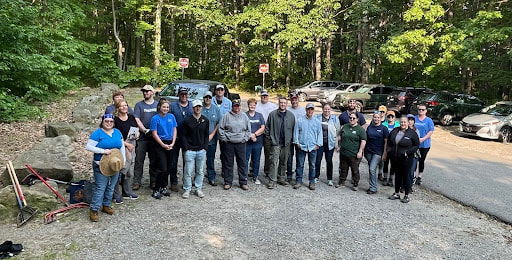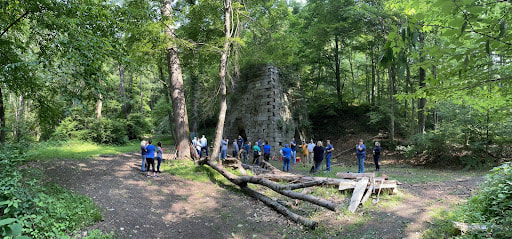|
My Civic Service Project was a clean up of the landscape around the Henry Clay Furnace located on the Coopers Rock State Forest. This project consisted of four principal tasks: clearing brush and saplings from the area to the right of the furnace; clearing brush and string trimming the area to the left of the furnace; clearing the brush for a trail between the Henry Clay Furnace Trail and Clay Run; and lastly pruning all vegetation from the furnace that could be reached from the ground. The Henry Clay Furnace Clean Up project was scheduled to take place from 9:00 am to 1:00 pm. By around 9:00 am, twenty four volunteers from First Energy Corporation convened at the Henry Clay Furnace Parking Lot. This was a diverse group coming from various power stations and included more than one manager. Adam Polinski, of the Coopers Rock Foundation, an organizer of many Coopers Rock State Forest volunteer projects, and who aided me in recruiting the volunteers, went over organizational matters with the volunteers. I then gave a short history of the Henry Clay Furnace. Following this brief orientation, every volunteer grabbed a tool or two from the assortment of rakes, mattocks, shovels, saws, and a pair of gloves provided by the Forest and made their way down the Henry Clay Furnace Trail to the furnace. Once at the furnace, teams were formed and the work commenced. Over the next four hours, volunteers cleared the saplings and other woody plants from the area to the right of the furnace and raked up much of the leaves and other debris. These efforts paid off and new stone foundations were revealed. In the meantime, a crew of volunteers pruned all reachable vegetation from the furnace. Another volunteer (actually my next door neighbor) brought his gas powered string trimmer and made quick work of trimming the grass in the area left of the furnace. Another group removed saplings and grapevines in this same area to reveal the foundations of an unidentified structure. At 11:30 am, everyone took a break and I used this time to explain how the furnace operated and the difficulties of getting the finished products to market. Work resumed and large downed branches were cut up and dragged to the brush pile. Other volunteers continued with raking, while a smaller crew cut a trail to Clay Run. At 12:30 pm, as the planned work was winding down, we added one last work activity. While this last activity of the day wasn’t part of the proposed work plan, it was on my wish list for the furnace site, so it was undertaken anyway, given we had such a large workforce. We organized a rock brigade to gather rocks and stones from Clay Run and passed them from volunteer to volunteer up the hill to me. I then placed the rocks and stones in a loose fashion along the gully created on the left side of the furnace by mountain bikers riding down the bank behind the furnace. It is hoped that this rock paving will create obstacles that will deter future mountain bikers from riding down this slope, which is deleterious to the hillside behind the furnace. At this point, it was 1:00 pm and thanks were made to the group as they readied to depart. They gathered up tools and made their way back up the trail to the parking lot. Many of the volunteers had to return to work. Without a doubt my AmeriCorps Civic Service Project was a complete success. I believe that its success was directly related to the desire of the twenty four First Energy volunteers to give freely of their time and their willingness to work hard. Ultimately I believe that the results of my Civic Service Project will continue to bear fruits for many years to come. The Henry Clay Furnace sits at the junction of five trails and while not necessarily a destination, it is frequently visited by hikers and bikers. With the site cleaned up it will make it more of a destination and hopefully in the near future new interpretive signage will be installed explaining how the furnace worked and the function of the foundations revealed in the clean up. Lee R. MaddexLee served as a Preserve WV AmeriCorps member with the Morgantown History Museum during the 2022-2023 program year.
Adam Polinski
7/8/2023 07:14:50 pm
Lee, that was a day to remember and a turning point for the Iron Furnace site. A great all-around effort that had the support of the Coopers Rock Superintendent, WV DNR, as well. Every single person there that day made a real contribution and I look forward to continuing with the vision of adding a lot more interpretive signage — there’s so much more to tell than what the current signs contain. Good job🏆 Comments are closed.
|
Preserve WV StoriesCategories
All
Archives
August 2023
|
Get Involved |
Programs |
Contact UsPreservation Alliance of West Virginia
421 Davis Avenue, #4 | Elkins, WV 26241 Email: [email protected] Phone: 304-345-6005 |
Organizational Partners:
© COPYRIGHT 2022 - PRESERVATION ALLIANCE OF WEST VIRGINIA. ALL RIGHTS RESERVED.





 RSS Feed
RSS Feed



